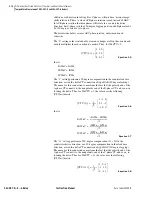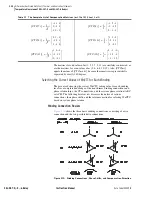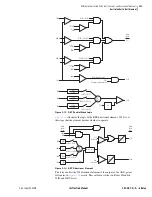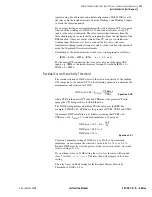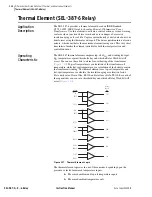
3.23
Date Code 20050919
Instruction Manual
SEL-387-0, -5, -6 Relay
Differential, Restricted Earth Fault, Thermal, and Overcurrent Elements
Temperature Measurement (SEL-387-5 and SEL-387-6 Relays)
CTs on the wye side, using the same CT delta connection as the
primary of the transformer. Perform the following simple steps to
handle these traditional connections.
Step 1.
Establish the line terminal directions.
Refer to the line following the transformer drawings in
and note that the delta winding A line terminal
direction is at 30 degrees CCW from the A winding direction
(vertical), as we would expect for a DAB connection with ABC
phase rotation. The A winding of the 24.9 kV winding is vertical.
shows the A winding of the 14.4 kV winding at 120
degrees CCW from vertical, to make the example more
interesting.
Step 2. Adjust the CT connections.
In this case the two windings with wye CTs need no adjustment.
The 24.9 kV winding, with DAB CTs, needs a 30-degree
correction in the CCW direction.
shows this
adjustment in the second line under the transformer drawings.
Step 3. Select a reference direction for the transformer.
You can use one of the three winding directions as the
reference, but this need not be the case. You could establish
any of the 12 possible directions, separated by 30 degrees
around the complete circle of 360 degrees, as the reference. All
three windings would then receive adjustments to correlate
them with this reference. As
illustrates, the primary
winding direction serves as reference in the example.
Step 4. Choose the WnCTC settings for all three windings.
Because Winding 1 is the reference, we need no adjustment; the
setting is W1CTC = 0. Note that the adjusted Winding 2 inputs
coincide exactly with the reference direction; we need make no
adjustment for the 24.9 kV winding either. Therefore, the
setting is W2CTC = 0. As mentioned earlier, these two windings
represent a classical DABY application. We can see this from
the fact that the WnCTC setting is zero for both windings. The
CT connections themselves perform exactly the right
correction without additional help from the relay. The final
winding inputs still reside at the "8 o'clock" position and need
adjustment to the reference at "11 o'clock." Beginning at the
Winding 3 direction, the compensation direction is CCW until
arrival at the reference. This compensation requires nine
increments of 30 degrees (or 9 "hours") in the CCW direction.
We therefore set W3CTC = 9. The process is nearly complete.
Step 5. As a final step, ensure that no wye-connected winding having
wye-connected CTs is set at WnCTC = 0 (uncompensated).
Were this the case, zero-sequence currents could appear in
these relay inputs but in no others, and a possible false trip
could occur for external ground faults. Any non-zero value of
WnCTC will eliminate the zero sequence. In this example the
only wye winding with wye CTs is Winding 3, which we have
compensated by W3CTC = 9. The selection is complete. The
relay receives the three settings as W1CTC = 0, W2CTC = 0, and
W3CTC = 9.
EXAMPLE 3.2
Example 2 for WnCTC Selection
illustrates the second example. This is another three-
winding transformer, for which we have chosen rather unusual
winding phase relationships in order to show the flexibility of the
winding compensation feature in the SEL-387.
The transformer has a 115 kV primary winding that is wye connected,
with wye-connected CTs. The 34.5 kV secondary winding is DAB
connected, but designated with the A line terminal at the "7 o'clock"
position with respect to the primary A line terminal. It has wye-
connected CTs. The 12.47 kV winding is another wye-connected
winding, but with delta-connected CTs. The CTs connect in a DAC
delta rather than DAB. However, this poses no problem for the relay.
Summary of Contents for SEL-387-0
Page 10: ...This page intentionally left blank ...
Page 16: ...This page intentionally left blank ...
Page 56: ...This page intentionally left blank ...
Page 350: ...This page intentionally left blank ...
Page 388: ...This page intentionally left blank ...
Page 456: ...This page intentionally left blank ...
Page 494: ...This page intentionally left blank ...
Page 528: ...This page intentionally left blank ...










